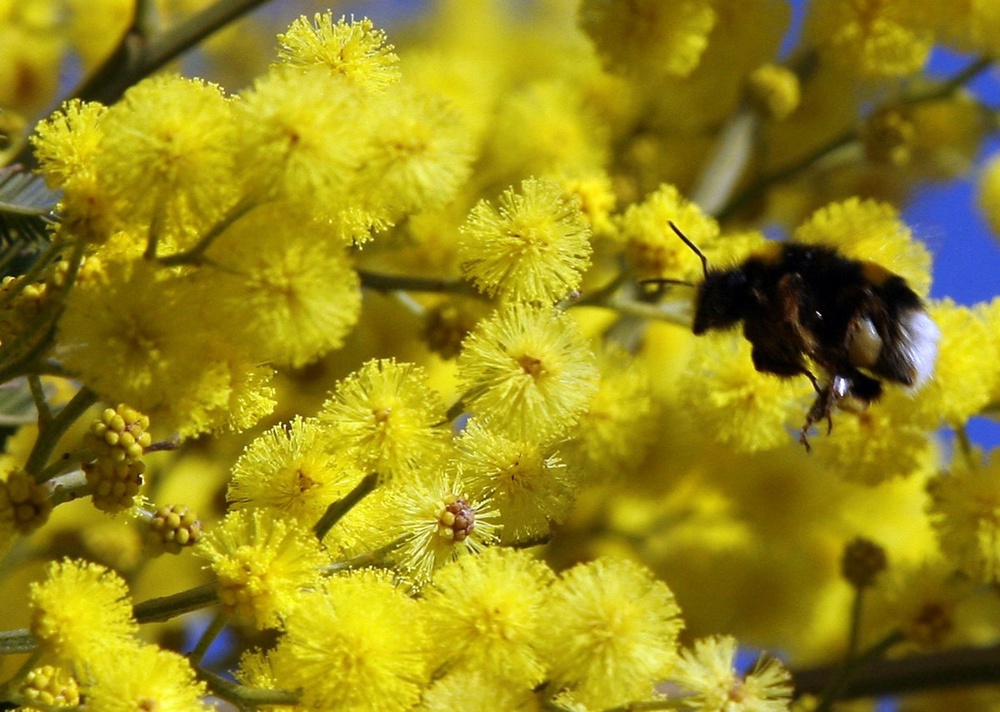
Like miniature pompoms bursting with colour and fragrance, mimosa flowers turn the hills around France's perfume capital, Grasse, a golden yellow for a couple of fleeting weeks each year, AFP reports.





Like miniature pompoms bursting with colour and fragrance, mimosa flowers turn the hills around France's perfume capital, Grasse, a golden yellow for a couple of fleeting weeks each year, AFP reports.
Though they fade fast -- and must be processed as soon as they are harvested -- a second life awaits these harbingers of spring as a prized ingredient in some of the world's most coveted scents.
"Mimosa is still a perfumer's mainstay," says Sebastien Plan of Robertet, a major international supplier of the raw ingredients that go into perfumes.
Mimosa's heady fragrance, which enjoyed a heyday from the 1950s through the '70s, is used in tiny amounts today. Modern perfumes tend to be "subtler, with a good, clean and smooth" effect, says Robertet.
Yet it can still "become a perfume's secret ingredient," he says.
"Mimosa has a fresh, floral, slightly powdery, almost honeyed aspect, which blends with the green scent of the stems," he adds, admitting a preference for the stronger wild variety.
From a harvest of around 40 tonnes of flowers, Robertet produces some 400 kilos (880 pounds) of a rock-like substance called "concrete" -- which is in turn purified into about 100 kilos of "absolute".
Jean-Pierre Roux, the boss of the Grasse perfumery Galimard, pays tribute to this "symbol of the Grasse terroir" by distilling the flowers into a refreshing cologne, popular with visitors who come to see the mimosas in bloom.
Grasse, situated on the French Riviera, has long been France's perfume capital. Fields of Provence roses and jasmine sprung up around the area in the 17th century when local tanners started scenting their leather products -- especially gloves -- with fragrant floral oils, which are still used today to make luxury perfumes such as Chanel No. 5.
Galimard's perfumer Caroline de Boutiny admits that its mimosa scent is more popular with older customers than with the young.
The strong mimosa absolute is little used in modern fragrances, but it can "lend weight to a composition with its honeyed and powdered notes", she said.
Luxury perfume brands Kenzo and Guerlain use it for this quality in their toilet waters, de Boutiny said.
'Like velvet'
The mimosa tree arrived in France from Australia in the mid-19th century as a decorative plant for gardens and still forms a luxurious forest on the Tanneron hills west of Grasse.
"Mimosa is like velvet," says Gilbert Vial, an 85-year-old "mimosist" who has never left the town of Tanneron.
This year, he said, the blossoms have only flowered for a brief period. To lengthen the season, local mimosa growers first plant the mirandole variety, which flowers in December and January, followed by the rustica and gaulois varieties, which bloom in February and March.
Vial, whose family has sold mimosa bouquets for three generations, has little time for the secret world of the perfume industry. These days he can no longer even discern the scent of mimosa, even as it pervades his small village shop.
Yet the declining use of the flowers in the fragrance industry is being felt here. Vial's 60-year-old son is the last in line to harvest the steep slopes of the family's six hectares (15 acres). "Before the frost of 1956, thirty families grew mimosa in Tanneron. Today there are just three or four of us," he said.
Many perfumers prefer synthetic ingredients that closely resemble mimosa and are less onerous to produce.
Globalisation of production has also affected French growers, who now face competition from cheaper producers in far-flung countries.
Even some Grasse suppliers, like Robertet, today import cheaper mimosa "concrete" from Indian suppliers.
"Previously, six train cars left five days a week from Cannes heading to England," Vial said. "Then, there was no other source of flowers in winter. Nowadays, flowers arrive from all over the world."


 +7 (777) 001 44 99
+7 (777) 001 44 99















































